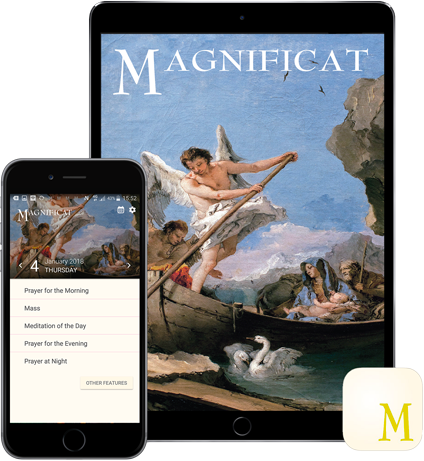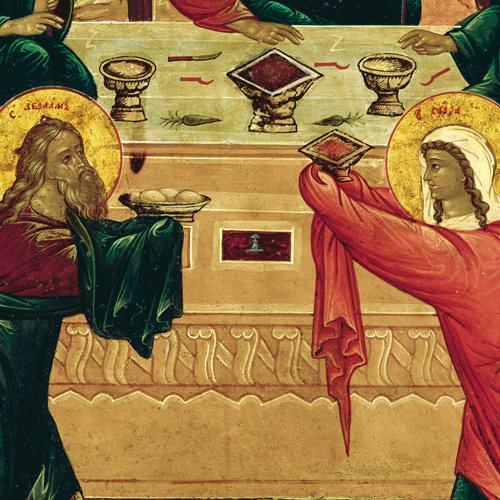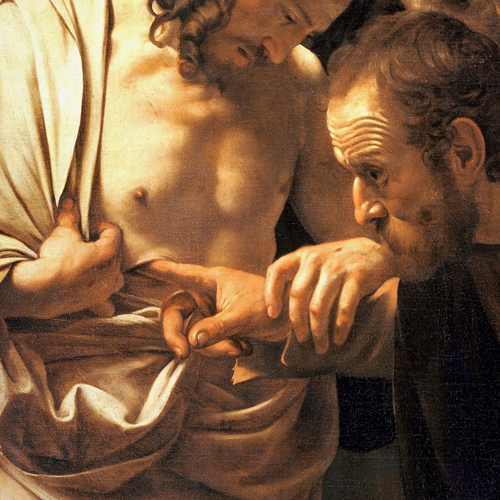The article of the month
This Month… by Teresa Caldecott Cialini
The traditional devotion for July, the Most Precious Blood of Jesus, can be a tough theme to latch on to. What is this blood that cleanses instead of staining? It is the life-force that flows from our Saviour, stemming from his Sacred Heart. It is the sign of our association with him, whether it is painted on our doorposts in the manner of the Israelites, shed in his name by the martyrs, or received by in the Eucharist. It is the very mechanism of the Covenant that makes us children of God—that makes us family.
Saint John Paul II wrote extensively on the nature of covenants in his work on the Theology of the Body. In an 1982 speech he said that “Jesus goes to the end of love (cf. Jn 15:13; 13:1), he seals the Covenant in the blood of his Cross, and ‘gave up his spirit’ (Jn 19:30) to the Church, his Bride. The Church thus appears as the end-goal of the Covenant: filled with the gift of God, she is the beloved and fruitful Bride who generates new children until the end of time.” As Saint Paul says in the Letter to the Ephesians (1:5-8), he destined us in love to be his sons through Jesus Christ…. In him we have redemption through his blood, the forgiveness of our trespasses, according to the riches of his grace which he lavished upon us.
Generating New Children
There can be no “new children” without blood. Birth and death are mirrors of one another. Beyond the element of suffering and cost though, it is just as fruitful to reflect on the fact that where physical childbirth is concerned, blood is the channel of relationship and sustenance for the baby up until the moment when the cord is severed. The blood of the mother and child, joined across the placenta in utero to allow the mother’s body to nourish the child, also, fascinatingly, carries back to the mother cells from the child that linger in the mother’s body for years to come. Similarly, the Blood of the Covenant is a channel of connection to, and dependency on our creator, but there is something we give back to the Body of Christ when we respond to that relationship.
In the life of our spiritual family, the Church, we know we become One by receiving the Body and Blood of our Lord at the Eucharistic altar, but in the martyrs we see another way that blood generates new life. Take one story concerning the spiritual children of a Saint Ignatius of Loyola, whom we celebrate at the end of July: Saint Ignatius founded the Jesuits in 1534, the same year that the Church of England was established with the passing of the Act of Supremacy. Hundreds of Jesuit missionaries gave their freedom, safety, and often their very blood, to serve persecuted Catholics in England, Wales, and Scotland in the centuries that followed and bring them the Sacraments. Many of these were brilliant men who inspired others through their words and writings, such as Edmund Campion and Robert Southwell, as well as through their brave deaths. Strikingly, one of the Jesuit martyrs, Henry Walpole, left his law practice to follow in Campion’s footsteps after witnessing his execution and literally being sprinkled with his blood.
These and other martyrs are the most obvious examples of the people who have been through the great persecution, and because they have washed their robes white again in the blood of the Lamb, they now stand in front of God’s throne and serve him day and night in his sanctuary (Rv 7:14b). Tertullian famously wrote that “the blood of Christians is seed” for the Church. Saint James, brother of John, whose feast falls on 25 July, was the first of the Apostles to shed his blood and let fall that seed. Oliver Plunket, whose feast day is 1 July, was the most recent to do likewise in our own shores. Father Friedrich Lorenz, who is quoted in the Meditation for the feast of Saint James, made explicit his own union with the Precious Blood of Christ shortly before he was executed by the Nazis: “Blood flowed on the cross; blood flows on our altars in a renewal of the sacrifice on the cross. My droplet of blood mingles with this blood for the adoration, honour, and glorification of God, whose servant I have been.”
Thomas’ Contribution
There is an inescapable physicality to Christianity in our Sacraments, our language, our art. Take the painting by Caravaggio featured in our Art Enclosure this month, depicting Saint Thomas’ encounter with the risen Jesus in graphic detail. This moment, where Christ invites the “doubting” apostle into the physical reality of his wounds, is a great gift to future Christians, fleshing out (if you’ll excuse the pun) our understanding of the Resurrection of the Body and the need to hold fast to the Sacraments. “O Jesus, most profound abyss of mercy,” writes Saint Bridget of Sweden (23 July), “I beseech you…hide me in the hollow of your wounds”.
The “Saints Who Championed the Eucharist” in this issue remind us that we need to take Christ at his word. Turning back to Saint John Paul II: “The Eucharist makes the Covenant accessible to us, [it is] simultaneously the gift and he who gives himself. As the supreme Sacrament of the Covenant, the Eucharist is a mystery of communion, of unity, in respect for each person: ‘He who eats my flesh remains in me and I in him’ (Jn 6:56). ‘Just as…I live because of the Father, so he who eats my flesh will live because of me’ (Jn 6:57). It manifests the communion of the Father and the Son in the Spirit, drawing into this communion the faithful, who thus find themselves to be in communion with one another (cf. 1 Co 10:17). Through the flesh of the Risen Christ, communion in the Spirit is accomplished: ‘He who is united to the Lord becomes one spirit with him’ (1 Co 6:17).” A depiction of this Trinitarian-Eucharistic dynamic can be found on this month’s cover.







